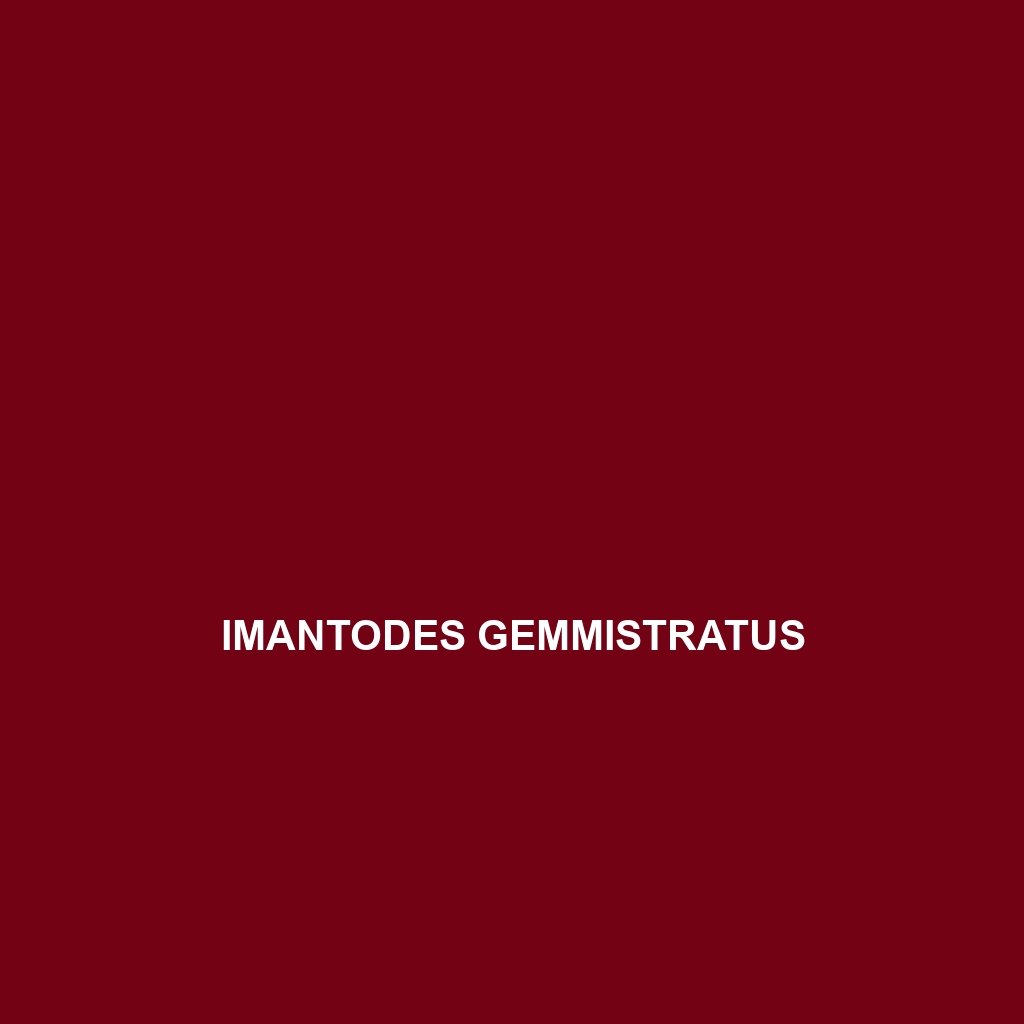Common Name
Imantodes gemmistratus
Scientific Name
Imantodes gemmistratus
Habitat
The Imantodes gemmistratus, commonly known as the spotted slug snake, is primarily found in the lush environments of Central and South America. This species inhabits tropical and subtropical rainforests, where the warm climate and ample vegetation offer the perfect backdrop for its unique behaviors. Typically residing at elevations ranging from sea level to about 1,000 meters, these snakes prefer moist areas near rivers and streams, allowing them to thrive in environments rich in biodiversity. In addition, they can sometimes be found in adjacent savannas and temperate forests, where they utilize their agile bodies to navigate through dense underbrush and leaf litter.
Physical Characteristics
Imantodes gemmistratus exhibits a striking appearance that aids in its camouflage among foliage. Adult individuals usually range from 70 to 100 centimeters in length, though some can reach lengths of up to 120 centimeters. They possess a slender body covered in smooth, glossy scales that feature a beautiful pattern of dark brown to greenish coloration, accented with lighter spots and bands. This unique coloration not only allows them to blend seamlessly into their surroundings but also plays a role in thermoregulation. Their heads are elongated, which aids in capturing prey hidden within vegetation, and their eyes are large, providing excellent vision at night.
Behavior
The Imantodes gemmistratus is primarily nocturnal, displaying a range of behaviors adapted to hunting and avoiding predators under the cover of darkness. During the day, these snakes can be found resting on tree branches or among dense foliage, where they wait to ambush prey. Socially, they are mostly solitary creatures, but during the mating season, males may engage in elaborate courtship displays to attract females. Their movement is characterized by slow, deliberate motions, which help maintain stealth, while their ability to climb makes them exceptional hunters among the canopy.
Diet
The diet of Imantodes gemmistratus primarily consists of small invertebrates, making them insectivores. They have been observed preying on a variety of small creatures such as frogs, lizards, and other soft-bodied animals. Their method of hunting involves using constriction, allowing them to subdue their prey effectively. They have a unique feeding pattern; after striking their prey, they hold it tightly before consuming it whole, which is a common trait among many snake species.
Reproduction
Imantodes gemmistratus has a reproductive cycle that typically occurs during the rainy season, which provides a more favorable environment for the survival of offspring. Mating takes place in the spring, with females laying clutches of 5 to 12 eggs in leaf litter or hidden in tree cavities by mid-summer. The eggs, which are leathery, usually hatch after a period of 60 to 75 days, depending on environmental conditions. Newborn snakes are around 20 to 30 centimeters long at birth. Parental care is minimal, with the young being entirely self-sufficient shortly after hatching.
Conservation Status
Currently, the Imantodes gemmistratus is categorized under the ‘Least Concern’ status by the International Union for Conservation of Nature (IUCN). However, habitat loss due to deforestation and agricultural expansion poses significant threats to this species. Conservation efforts are vital in preserving their habitat and mitigating the impact of human activity. Environmental organizations are working to raise awareness and establish protected areas to ensure the survival of these and many other native species.
Interesting Facts
One fascinating aspect of the Imantodes gemmistratus is its ability to change color slightly in reaction to its environment and emotional state. This adaptive feature not only helps with camouflage but also aids in regulating body temperature. Additionally, these snakes have developed a unique method of locomotion that allows them to glide in short distances, making them agile hunters capable of traversing through trees efficiently. The spotted slug snake’s non-venomous nature allows for a fascinating interaction with other rainforest species, contributing to its ecological niche.
Role in Ecosystem
The Imantodes gemmistratus plays an essential role in its ecosystem, acting as both predator and prey. As an insectivore, it helps to regulate populations of small animals, maintaining a balance within its habitat. This species contributes to the health of the rainforest by supporting biodiversity and serving as a food source for larger predators. Due to its role in the food chain, the presence of Imantodes gemmistratus is an indicator of a healthy and sustainable ecosystem, reinforcing the importance of conservation efforts aimed at preserving its habitat.
